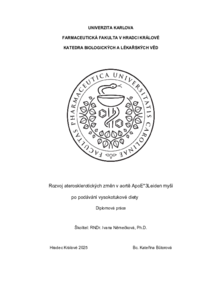Rozvoj aterosklerotických změn v aortě ApoE*3Leiden myší po podávání vysokotukové diety
Development of atherosclerotic changes in the aorta of ApoE*3Leiden mice after administration of a high-fat diet
diploma thesis (DEFENDED)

View/
Permanent link
http://hdl.handle.net/20.500.11956/198977Identifiers
Study Information System: 264823
Collections
- Kvalifikační práce [6885]
Author
Advisor
Referee
Nachtigal, Petr
Faculty / Institute
Faculty of Pharmacy in Hradec Králové
Discipline
Bioanalytical laboratory diagnostics in health care
Department
Department of Biological and Medical Sciences
Date of defense
28. 5. 2025
Publisher
Univerzita Karlova, Farmaceutická fakulta v Hradci KrálovéLanguage
Czech
Grade
Excellent
5 ABSTRAKT Ateroskleróza je multifaktoriální zánětlivé progresivní onemocnění postihující zejména střední a velké artérie. Aterogeneze je charakteristická dlouhodobou akumulací lipidových částic ve stěně cévy. Pokud se aterosklerotická léze rozvíjí po několik dekád může způsobit až okluzi postižené artérie. Další reakcí organismu na progredující aterosklerózu je zánět, který aktivuje cévní endotel a vyvolá uvolňování mediátorů zánětu. Dále dochází k oxidaci ukládajících se LDL částic na oxLDL, které jsou pak pohlcovány makrofágy za vzniku pěnových buněk. Cílem této práce bylo zjistit, zda po podávání vysokotukové diety s 1% obsahem cholesterolu dojde k rozvoji aterosklerosklerotických změn. V experimentu byl použit myší model ApoE*3Leiden.CETP transgenních myší. Kontrolní skupina byla krmena standardní laboratorní dietou, experimentální skupině byla podávána po dobu 10 týdnů vysokotuková dieta s 1% obsahem cholesterolu (HFD). Pro histologické hodnocení změn byly použité parafínové řezy aorty, které byly obarveny hematoxylinem a eosinem. Exprese vybraných markerů endoglinu, VCAM-1 a galektinu-3 byla analyzována metodou nepřímé imunohistochemie a exprese galektinu-3 byla navíc kvantifikována pomocí metody western blot. Výsledky této práce ukazují indukci rozvoje aterosklerotických změn od přítomnosti pěnových...
6 ABSTRACT Atherosclerosis is a multifactorial inflammatory progressive disease affecting mainly medium and large arteries. Atherogenesis is characterized by long-term accumulation of lipid particles in the vessel wall. If an atherosclerotic lesion develops over several decades it can cause occlusion of the affected artery. Another response of the body to progressive atherosclerosis is inflammation, which activates the vascular endothelium and induces the release of mediators of inflammation. Furthermore, oxidation of deposited LDL particles to oxLDL occurs, which are then taken up by macrophages to form foam cells. The aim of this study was to determine whether atherosclerotic changes develop after a high-fat diet containing 1% cholesterol. A mouse model of ApoE*3Leiden.CETP transgenic mice was used in the experiment. The control group was fed a standard laboratory diet, and the experimental group was fed a high-fat diet with 1% cholesterol (HFD) for 10 weeks. Paraffin sections of the aorta were used for histological evaluation of changes and were stained with hematoxylin and eosin. Expression of selected markers of endoglin, VCAM-1 and galectin-3 was analyzed by indirect immunohistochemistry, and galectin-3 expression was additionally quantified by western blot. The results of this study show the...
